Anglia Ruskin University
Anglia Ruskin University (ARU) is in East Anglia, United Kingdom. Its origins are in the Cambridge School of Art, founded by William John Beamont in 1858. It became a university in 1992 and was renamed after John Ruskin in 2005. It is one of the “post-1992 universities”.
Former names | See History |
|---|---|
| Motto | Excellentia per societatem (Latin) |
Motto in English | Excellence through partnership |
| Type | Public university |
| Established | 1858 (as a school) 1992 (as a university) |
| Endowment | £0.7 m (2015)[1] |
| Chancellor | Michael Ashcroft |
| Vice-Chancellor | Roderick Watkins |
| Students | 24,490 (2018/19)[2] |
| Undergraduates | 19,630 (2018/19)[2] |
| Postgraduates | 4,860 (2018/19)[2] |
| Location | , United Kingdom |
| Campus | Urban |
| Colours | Blue and yellow |
| Affiliations | |
| Website | aru |
Anglia Ruskin has 39,400 students worldwide with campuses in Cambridge, Chelmsford, Peterborough and London. It shares further campuses with the College of West Anglia in King's Lynn, Wisbech and Cambridge and has partnerships with universities around the world including Berlin, Budapest, Trinidad, Singapore and Kuala Lumpur. There are four faculties of study at the university: Faculty of Business and Law, Faculty of Arts, Humanities & Social Sciences, Faculty of Health, Education, Medicine & Social Care and Faculty of Science & Engineering. The university's Lord Ashcroft International Business School (LAIBS) in Cambridge and Chelmsford is one of the largest business schools in the East of England. In 2019, the School of Medicine was formally opened at its Chelmsford campus by Prince Edward, Duke of Kent. It was awarded Entrepreneurial University of the Year in the 2014 Times Higher Education Awards. It won the Duke of York Award for University Entrepreneurship at the Lloyds Bank National Business Awards 2016.
History
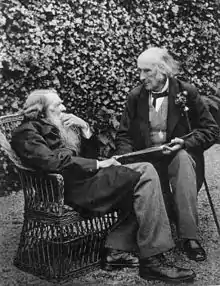
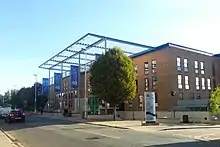
Anglia Ruskin University has its origins in the Cambridge School of Art, founded by William John Beamont in 1858. The inaugural address was given by John Ruskin[3] (often incorrectly described as the founder; in fact he founded the Ruskin School of Drawing in Oxford). The original location was near Sidney Sussex College, later moving to its present location in East Road, Cambridge. The governing body in the 1920s included two remarkable pioneers in the civic history of Cambridge, Clara Dorothea Rackham and Lilian Mellish Clarke after whom buildings on the East Road campus were later named. In 1960 this became the Cambridgeshire College of Arts and Technology (CCAT) In 1989 CCAT merged with the Essex Institute of Higher Education, which was originally a vocational school named Chelmsford School of Science and Art and was later known as Mid Essex Technical College and Chelmer Institute of Higher Education,[4] to form the Anglia Higher Education College. The merged college became a polytechnic in 1991, using the name Anglia Polytechnic, and was then awarded university status in 1992.
Initially Anglia Polytechnic University (APU), it retained the word 'polytechnic' in its title because "the term 'polytechnic' still had value to students and their potential employers, symbolising as it did the sort of education that they were known for – equipping students with effective practical skills for the world of work"[5] although in 2000 there was some self-doubt about including the term 'polytechnic' – it was the only university in the country to have done so. Wanting to keep the 'APU' abbreviation, a suggestion put forward by the governors was 'Anglia Prior University' (after a former Chancellor), but the Governors decided to keep 'polytechnic' in the title.
The university eventually reconsidered a name change and chose Anglia Ruskin University (thus incorporating into the title the surname of John Ruskin, who gave the inaugural address of the Cambridge School of Art), with the new name taking effect following the approval of the Privy Council on 29 September 2005.[6]
Former students included the Victorian poet, Augusta Webster, who signed John Stuart Mill's petition for votes of women in 1866. Past lecturers include Odile Crick, wife of Francis Crick, who created the simple iconic image of DNA.[7] The musician Syd Barrett, songwriter and leading guitarist of the band, Pink Floyd is an alumnus. Author Tom Sharpe was a lecturer in History at CCAT between 1963 and 1972 and Anne Campbell,[8] the Labour MP for Cambridge from 1992 to 2005, was formerly a lecturer in Statistics at CCAT. A blue plaque is to be erected to the leading educationalist, Dame Leah Manning in 2019 at the former ragged school in New Street which was acquired by the university in 2006 and converted into the Anglia Ruskin University Institute of Music Therapy.
Chelmsford Campus move
The Chelmsford Central campus closed at the end of the 2007/8 academic year, with all facilities moving to the new buildings at the Rivermead campus (now called the Chelmsford Campus) on Bishop Hall Lane.
Three buildings were saved – the East building (built 1931), the Frederick Chancellor building (built 1902), and the Grade-2-listed Anne Knight building (built in the mid-19th century), which was used by Quakers. The East and Frederick Chancellor buildings fall under a conservation area, meaning they cannot be demolished without planning permission, as they are historically important due to their uses in the early days of higher education in Essex. The site is currently vacant due to the recession halting development which had been planned for many years; however, new plans have been released by Genesis Housing, who currently own the site.[9][10][11]
The Chelmsford Campus facilities include a mock law court, mock hospital wards and operating theatres and labs.
Student complaints, 2014
In a BBC News article from 3 June 2014, Anglia Ruskin University was reported to have received more complaints and appeals from its students than any of the other 120 universities who responded to freedom of information requests. In the year 2012/13 it received 992 "complaints and appeals".[12] In response, Lesley Dobree, Deputy Vice Chancellor (Academic), said that only 9 of the 992 recorded complaints were actual complaints – the others were protests about examination and assignment marking. It is not known if the BBC responded to this, or if the other universities in the list were assessed by the same criteria.
The article further stated the case of a group of students from the Chelmsford campus, who were abruptly informed that their Legal Practice Course was moved 45 miles to the Cambridge campus. They would therefore be limited to only two days of face-to-face teaching, having to watch the remaining lectures online rather than attend them live.
In 2019 Pok Wong, a 2014 graduate of Anglia Ruskin University, received a £61,000 out-of-court settlement from the University in a dispute about of the quality of teaching. The University has maintained that the payout does not prove that the university was at fault.[13][14]
Entrepreneurship
Anglia Ruskin was awarded Entrepreneurial University of the Year in the 2014 Times Higher Education (THE) Awards.[15]
Campuses
The university has campuses in Cambridge, Chelmsford and Peterborough, University Centres in King's Lynn and Peterborough, and collaborative partnerships with institutions in a variety of locations throughout the world, including London, Berlin, Budapest, Athens, Basel, Kuala Lumpur, Singapore and Trinidad.
Facilities
Anglia Ruskin's Cambridge Campus is home to one of only 9 optometry schools in the UK, having its own optometry clinic.[16]

The Cambridge campus has recently been redeveloped, which began with the refurbishment of Helmore, the main building on East Road, completed in 2006. In 2009, one of the University's largest buildings, Rackham, in the centre of the campus, was demolished to make way for the new Lord Ashcroft International Business School. The Mumford Theatre, which presents a range of professional touring, local community and student theatre for both the public and members of the University, is housed at the centre of the campus. From 2015, a new building at Young Street hosted the health courses, like nursing, midwifery, paramedic, ODP etc.[17]
The Chelmsford campus houses the Queen's Building (opened in 1995) and the Sawyer's Building (opened in 2001). The Michael A Ashcroft Building opened in 2003 (renamed the Lord Ashcroft Building); the Mildmay Sports Centre, and the Tindal Building, in 2005; the William Harvey Building in 2007; The Faculty Building (renamed The Marconi Building in 2011) in 2008; and the Postgraduate Medical Institute building – named as Michael Salmon Building in 2017 -, opened 2011.[18][19] In May 2017, the work has started on the building of Essex's first School of Medicine.[20]
The Cambridge, Chelmsford, and Peterborough campuses have accommodation for students to live in during term-time.
Ruskin Gallery
The Ruskin Gallery is the university's public art gallery.[21] Admission is free. Exhibits have included historic and contemporary art, as well as works by students and staff. The gallery is surrounded by fine art, illustration, design, and media studios. On 9 May 2011 Ruskin Gallery unveiled its new digital gallery, which displays art in a digital format on High Definition screens, including the world's first Panasonic 103" 3D Full HD plasma screen.[22]
Images
 Mill pond at Anglia Ruskin University, Chelmsford campus
Mill pond at Anglia Ruskin University, Chelmsford campus Lord Ashcroft building at Anglia Ruskin University, Chelmsford campus
Lord Ashcroft building at Anglia Ruskin University, Chelmsford campus Lord Ashcroft building at Anglia Ruskin University, Chelmsford campus
Lord Ashcroft building at Anglia Ruskin University, Chelmsford campus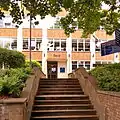 The David Building is the home of Animal and Environmental research within the Department of Life Sciences
The David Building is the home of Animal and Environmental research within the Department of Life Sciences Ruskin Building is part of the original 1858 premises, it is home to the Ruskin Gallery
Ruskin Building is part of the original 1858 premises, it is home to the Ruskin Gallery Coslett Building is the seat for Anglia Ruskin University Faculty of Science and Technology
Coslett Building is the seat for Anglia Ruskin University Faculty of Science and Technology
Organisation and administration
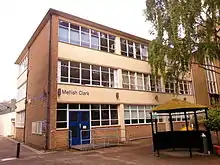
There are four Faculties of study at Anglia Ruskin University:[23]
- Faculty of Business and Law
- Faculty of Arts, Humanities & Social Sciences
- Faculty of Health, Education, Medicine & Social Care
- Faculty of Science & Engineering
HSHS, the former Homerton School of Health Studies, was acquired by the University from the Trustees of Homerton College in 2005, after working closely in partnership for a number of years.
Faculties and Schools
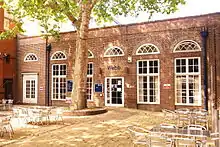
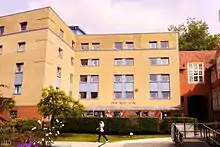
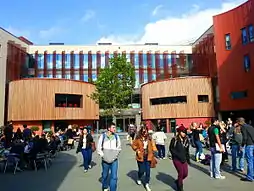
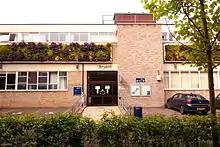
Lord Ashcroft International Business School
The university's Lord Ashcroft International Business School (LAIBS) in Cambridge and Chelmsford is one of the largest business schools in the East of England, with nearly 100 full-time teaching staff and approximately 7,200 students from over 100 countries.
LAIBS is a member of the EFMD and offers degrees. Several programmes of the LAIBS are accredited by ACCA and CIMA, and many other professional bodies in the United Kingdom.
Faculty of Science & Technology
The Faculty of Science & Technology was one of the largest faculties at Anglia Ruskin University, with six departments spread across both Cambridge and Chelmsford campuses.[24]
The Department of Built Environment was a large multidisciplinary department with the most comprehensive Built Environment portfolio in Eastern England and is based at the Chelmsford campus.[25]
The Department of Computing and Technology was located at both the Chelmsford and Cambridge campuses. The department maintained close links with the electronics, software, automotive and creative industries, and is a Cisco Systems Regional Networking Academy.[26]
The Department of Life Sciences was located at the Cambridge campus. State-of-the art industry-standard equipment for teaching includes well-equipped laboratories, gas and liquid chromatographic systems, and facilities for drugs analysis, toxicology, fire investigation and DNA analysis.[27]
The Department of Psychology was based at the Cambridge campus. It was recognised for its performance in the 2008 UK Research Assessment Exercise, making it the UK's top-rated Psychology department in a post-1992 university for the quality of its research.[28]
The Department of Vision & Hearing Sciences was based at the Cambridge Campus for Optometry and Ophthalmic Dispensing[29]
Research: Psychology, Vision, and Environmental Sciences research was rated as "world leading" or of "international" quality in the 2008 UK Research Assessment Exercise.[30] Successes include discoveries of new animal species,[31] design of new car bonnets for improved pedestrian safety,[32] and leading study in the first to study the toxic effects of benzylpiperazine (BZP).[33]
Faculty of Arts, Law & Social Sciences
The Faculty of Arts, Law & Social Sciences (ALSS) offered courses from Foundation to PhD level through its five departments, which include the Cambridge School of Art itself.
The faculty also housed the Anglia Ruskin University Language Centre, which provided language training and courses to students, staff and the general public, and supports 11 research clusters, including the Cultures of the Digital Economy Research Institute (CoDE) Research Institute.
Anglia Law School runs courses on both Cambridge and Chelmsford campuses, with a mock courtroom on each. Course provision includes undergraduate, postgraduate, research and professional qualifications. Their LLB (Hons) Law was rated in the top third of undergraduate law courses in the Guardian League Tables 2013.[34]
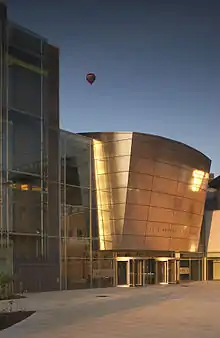
Cambridge School of Art is home to some 800 students studying for undergraduate, taught masters and doctoral qualifications. Its graduates include Syd Barrett and Dave Gilmour of Pink Floyd, Spitting Image Creators Peter Fluck and Roger Law and Creator of St Trinian's Ronald Searle.[35]
English, Communication, Film and Media. The department offered courses at undergraduate, postgraduate and research level over three programmes: Film and Media; English Literature, writing and publishing; and English Language and Intercultural Communication. Their Film and Media provision ranked in the top quarter, and BA (Hons) in the top third, of The Guardian University League Table 2013.[36]
Humanities and Social Sciences. Offered courses in History, Philosophy, Sociology, Public Service and Psychosocial Studies at undergraduate, postgraduate and degree level. Their History and Sociology provision both ranked in the top third of The Guardian University League Table 2013, while Philosophy ranked 16th.[37]
Music and Performing Arts. Offers courses at undergraduate level in Music, Drama, Creative Music Technology, Popular Music and Performing Arts and at postgraduate level in Music Therapy and Dramatherapy. Research Degree supervision is also offered in a range of subjects. The department organises a varied programme of events each semester, including Lunchtime Concerts, Anglia Opera and Festival Week, and provides individual instrumental and vocal tuition.[38]
Faculty of Health, Education, Medicine & Social Care
Following a restructure of the University in 2018 the Faculty of Medical Science and the Faculty of Health, Social Care and Education merged to form the new Faculty of Health, Education, Medicine and Social Care. The merger also involved a transition from a department organisation to a school based one. This saw the School of Economics, Finance and Law move to the new Faculty of Business and Law. The University now contains 13 schools.
The Faculty of Health, Social Care & Education was based in Chelmsford, Cambridge, and Peterborough. The Faculty is divided in 5 departments including Acute Care, Allied Health & Medicine, Education, Family & Community Studies and Primary & Public Health.
The Faculty of Health, Social Care & Education offers courses over a range of study levels, from foundation and undergraduate degrees to postgraduate qualifications. A variety of disciplines were available from nursing, operating department practice and social work to midwifery, education studies, public health and laparoscopic surgery.
The former Faculty of Medical Science built on the international reputation of ARU's Postgraduate Medical Institute (PMI) on its Chelmsford campus, the Faculty of Medical Science (FMS) opened in 2014. The Faculty runs courses at the Department of Allied & Public Health and the Department of Medicine & Healthcare Science. It is home to the university's nascent School of Medicine which is the third department of this Faculty. The Faculty offers medical and clinically-focussed undergraduate, postgraduate and doctoral level degrees.
It merged with the Faculty of Health, Social Care and Education in 2018 to become the new Faculty of Health, Education, Medicine and Social Care.
On 10 October 2016 Anglia Ruskin announced that they planned to open Essex's first School of Medicine at its Chelmsford Campus.[39] The purpose built brand new medical school would be the first undergraduate medical school in Essex and would cost £20-million to build. The medical school would include state-of-the-art skills facilities, specialist teaching space, a lecture theatre and a cadaveric anatomy suite.
On 19 May 2017 Anglia Ruskin announced that it has begun works to build the purpose built medical school on its Chelmsford Campus, due to be opened in September 2018.[20] Chief Executive of Basildon and Thurrock University Hospitals NHS Foundation Trust, Mid Essex Hospital Services NHS Trust and Southend University Hospital NHS Foundation Trust, Clare Panniker, attended the event alongside other officials.
On 21 September 2017, the university announced that the General Medical Council had approved its curriculum and that the university now had official School of Medicine status.[40] In 2019 the School was formally opened by Prince Edward, Duke of Kent.
ARU Peterborough
On 14 July 2020 the Minister of State for Universities Michelle Donelan has announced Anglia Ruskin University (ARU) as the official higher education partner for a new employment-focused university in Peterborough, an initiative by the Cambridgeshire and Peterborough Combined Authority (CPCA) in collaboration with Peterborough City Council (PCC).
Research Institutes
Anglia Ruskin has 7 research institutes.
- Cambridge Institute for Music Therapy Research
- Global Sustainability Institute
- Policing Institute for the Eastern Region
- Positive Ageing Research Institute
- StoryLab Research Institute
- Veterans and Families Research Institute
- Vision and Eye Research Institute] (formerly Vision and Eye Research Unit, VERU
Academic profile
Research
The 12 subject areas within Anglia Ruskin classified by the Research Excellence Framework (REF) 2014 as producing "world-leading" research are: Allied Health Professions, Dentistry, Nursing and Pharmacy; Architecture, Built Environment and Planning; Art and Design: History, Practice and Theory; Business and Management Studies; Communication, Cultural and Media Studies, Library and Information Management; English Language and Literature; Geography, Environmental Studies and Archaeology; History; Law; Music, Drama, Dance and Performing Arts; Psychology, Psychiatry and Neuroscience and Social Work and Social Policy.[42]
An investigation performed at the end of 2007 by the QAA reveal that as a result of its investigations, the audit team's view of Anglia Ruskin University is that "confidence can reasonably be placed in the soundness of the institution's present and likely future management of the academic standards of the awards that it offers and the quality of the learning opportunities available to students".[43] However, an external inspection of Initial Teacher Education revealed inadequacies in 2010. The areas highlighted were the effectiveness of the provision in securing high quality outcomes for trainees, and the extent to which the training and assessment ensures that all trainees progress to fulfill their potential given their ability and starting points.[44] It was only the Primary ITE that was found to be inadequate in the inspection, the Secondary and FE ITE were awarded a mark of satisfactory. Since this inspection, the Primary ITE has been awarded 'satisfactory' grades by Ofsted in May 2011 and 'good' in 2012.
Rankings
| National rankings | |
|---|---|
| Complete (2021)[45] | 113 |
| Guardian (2021)[46] | 99 |
| Times / Sunday Times (2021)[47] | 120 |
| Global rankings | |
| THE (2021)[48] | 301–350 |
| British Government assessment | |
| Teaching Excellence Framework[49] | Silver |
Anglia Ruskin was named the UK 'Entrepreneurial University of the Year' at the Times Higher Education (THE) Awards 2014.[50] Anglia Ruskin University was awarded a First in the Green League 2012 by People & Planet.[51] The league is based on ten environmental criteria, both policy and performance related. It incorporates data obtained through the Freedom of Information Act, including the percentage of waste recycled and CO2 emissions for each individual institution. Anglia Ruskin University has been named as one of the most upwardly mobile universities in the world.[52] The list, produced by Higher Education strategy consultants Firetail and published by Times Higher Education, includes Anglia Ruskin as one of the 20 "rising stars" in global Higher Education. Anglia Ruskin is the only UK university to feature in the top 20. Nine of the "rising stars" are located in the United States, with universities in Australia, South Korea, Japan, Germany, and Finland completing the list. Anglia Ruskin University (ARU) is ranked within the top 350 universities in the world and ranked joint 38th in the UK by the Times Higher Education World University Rankings 2020.[53]
It was awarded Entrepreneurial University of the Year in the 2014 Times Higher Education Awards. It won the Duke of York Award for University Entrepreneurship at the Lloyds Bank National Business Awards 2016.[54]
Notable alumni
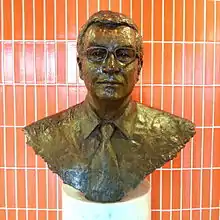
- Michael Ashcroft, Baron Ashcroft, English investor, billionaire and former Conservative vice chairman
- Eddie Ballard, former English cricketer for Cambridge UCCE and Hertfordshire
- Syd Barrett and David Gilmour, Pink Floyd members
- Chris Beckett, academic, author and science-fiction novelist
- Manish Bhasin, sports journalist and BBC presenter
- Henry Brock, specialist linguist at University of Cambridge and illustrator
- John Burnside, academic and T. S. Eliot Prize winning author
- Elsie Vera Cole, artist
- Nick Crane, English geographer and TV presenter
- Sarah-Jane Crawford, TV Presenter, Radio Presenter and Model
- Geraldine Finlayson, researcher and director of John Mackintosh Hall
- Peter Fluck and Roger Law, creators of Spitting Image
- Angela Hartnett, entrepreneur and chef
- Kim Howells, Labour politician and former Chair of the Intelligence and Security Committee
- Patrick Le Quément, automobile engineer and former chief designer at Renault
- Devant Maharaj, former Senator and Minister of Food Production, Trinidad and Tobago
- Ian Miller, English footballer
- Tony Palladino, English cricketer
- Shoo Rayner, author and illustrator
- Philip Reeve, author and illustrator of children's books
- Nicky Richards, CEO and Chief Investment Officer MLC Asset Management
- Andrew Sayer, English economist, professor of Social Theory and Political Economy at Lancaster University
- Patricia Scotland, Baroness Scotland of Asthal, Labour politician, Commonwealth Secretary-General, government policy-maker, former minister, attorney general and president of Chatham House
- Ronald Searle, creator of St Trinian's
- Michal Shalev, author and illustrator of children's books
- Mark Wood, businessman, accountant and chairman of NSPCC
- Barbara Yung, Hong Kong actress
Controversies
Depriving the degree of pro-Beijing lawmaker Junius Ho
During 2019–20 Hong Kong protests, pro-Beijing lawmaker Junius Ho, who was an alumnus of the university, had been making speeches which attacked women and members of the LGBTQ+ community, as well as supporting racism and massacres. Ho was also accused for involvement in 2019 Yuen Long attack.[55]
In response to the controversial speech by Ho, David Alton wrote to the University regarding the matter. Lord Alton urged the University to retract Ho's honorary doctoral degree. It was confirmed by the university that Ho was deprived of his degree on 29 October 2019.[56][57]
Notes
- "ARU Annual Report 2014-2015" (PDF). Anglia Ruskin University. p. 27. Retrieved 30 October 2016.
- "Where do HE students study?". Higher Education Statistics Agency. Retrieved 1 March 2020.
- Ruskin, John (29 October 1858), Cambridge School of Art: Mr Ruskin's Inaugural Address (Transcript of speech), London: Bell & Daldy (published 1858), retrieved 22 February 2013
- "Working at Anglia Ruskin University" (PDF). Anglia Ruskin University. p. 4.
- Chopra Consultants (2005), Anglia Ruskin University, archived from the original on 19 October 2007, retrieved 22 February 2013
- "New name, new era – Anglia Ruskin University". 5 October 2005. Archived from the original on 31 January 2018. Retrieved 30 January 2018.
- "Cambridge Business News | Cambridgeshire Local Business & Corporate News". Cambridge-news.co.uk. Archived from the original on 26 September 2007. Retrieved 26 July 2010.
- "Anne Campbell (annecampbell.org.uk), Election". annecampbell.org.uk. 6 May 2005. Retrieved 26 July 2010.
- "City Park West (Former Central Campus)". Retrieved 16 July 2015.
- "Anglia – Five Years On". Retrieved 16 July 2015.
- "Archived copy" (PDF). Archived from the original (PDF) on 16 July 2011. Retrieved 4 April 2011.CS1 maint: archived copy as title (link)
- Abrams, Fran (3 June 2014). "University complaints by students top 20,000". BBC News.
- Busby, Mattha (2 June 2019). "Graduate receives £61,000 over 'Mickey Mouse degree' claim". The Guardian. ISSN 0261-3077. Retrieved 2 June 2019.
- "Graduate wins £60k over 'Mickey Mouse' degree". BBC News. 2 June 2019. Retrieved 2 June 2019.
- "Entrepreneurial University of the Year 2014". Anglia Ruskin. Archived from the original on 27 September 2015. Retrieved 26 September 2015.
- "University Eye Clinic". Archived from the original on 17 December 2012. Retrieved 16 July 2015.
- "Young Street – Anglia Ruskin University".
- http://www.anglia.ac.uk/ruskin/en/home/microsites/new_spaces/chelmsford_campus.html%5B%5D
- ISMS Anglia Ruskin University. "Chelmsford new developments – Chelmsford new developments – Anglia Ruskin University". Archived from the original on 23 July 2012. Retrieved 16 July 2015.
- "Work starts on Essex's first School of Medicine". Anglia Ruskin University. 19 May 2017. Retrieved 6 March 2019.
- "Ruskin Gallery". anglia.ac.uk. Retrieved 27 June 2018.
- Ruskin Gallery – Anglia Ruskin. anglia.ac.uk. Retrieved on 8 June 2012.
- "Academic Restructure". Anglia Students' Union.
- "About us – Welcome to the Faculty of Science & Technology". anglia.ac.uk. Retrieved 4 October 2016.
- Built Environment – Anglia Ruskin. anglia.ac.uk. Retrieved on 25 May 2012.
- Cisco Networking Academy – Anglia Ruskin. anglia.ac.uk. Retrieved on 25 May 2012.
- Life Sciences – Anglia Ruskin. anglia.ac.uk. Retrieved on 25 May 2012.
- Psychology – Anglia Ruskin. anglia.ac.uk. Retrieved on 25 May 2012.
- Vision and Hearing Sciences – Anglia Ruskin. anglia.ac.uk. Retrieved on 25 May 2012.
- Research Excellence – Anglia Ruskin. anglia.ac.uk. Retrieved on 25 May 2012.
- European ladybirds under threat from alien predator – Anglia Ruskin. anglia.ac.uk. Retrieved on 25 May 2012.
- 'Pedestrian-friendly' car bonnet revealed – Anglia Ruskin. anglia.ac.uk. Retrieved on 25 May 2012.
- Scientists are first to study toxic effects of BZP – Anglia Ruskin. anglia.ac.uk. Retrieved on 25 May 2012.
- Anglia Law School – Anglia Ruskin. anglia.ac.uk. Retrieved on 8 June 2012.
- Cambridge School of Art – Anglia Ruskin. anglia.ac.uk. Retrieved on 8 June 2012.
- Department of English, Communication, Film and Media – Anglia Ruskin. anglia.ac.uk. Retrieved on 8 June 2012.
- Department of Humanities and Social Sciences – Anglia Ruskin. anglia.ac.uk. Retrieved on 8 June 2012.
- Department of Music and Performing Arts – Anglia Ruskin. anglia.ac.uk. Retrieved on 8 June 2012.
- "School of Medicine will address pressing healthcare needs – Anglia Ruskin University". Retrieved 24 September 2017.
- "It's official: Essex has its first School of Medicine – Anglia Ruskin University". Retrieved 24 September 2017.
- "Anglia Ruskin Research Institutes".
- England, Higher Funding Council of. "404 – REF 2021". www.ref.ac.uk. Archived from the original on 10 April 2018. Retrieved 6 December 2018.
- "QAA Institutional Audit December 2007". Qaa.ac.uk. 14 December 2007. Archived from the original on 15 November 2010. Retrieved 26 July 2010.
- http://www.ofsted.gov.uk/oxedu_reports/download/%28id%29/119504/%28as%29/70000_343676.pdf%5B%5D
- "University League Table 2021". The Complete University Guide. 1 June 2020.
- "University league tables 2021". The Guardian. 5 September 2020.
- "The Times and Sunday Times University Good University Guide 2021". Times Newspapers.
- "World University Rankings 2021". Times Higher Education.
- "Teaching Excellence Framework outcomes". Higher Education Funding Council for England.
- "Archived copy". Archived from the original on 9 October 2016. Retrieved 11 October 2016.CS1 maint: archived copy as title (link)
- "People & Planet University League". 18 October 2016.
- "Which universities could challenge the elite by 2030?". 11 August 2016.
- "World University Rankings". 17 August 2016.
- "Anglia Ruskin University". The Complete University Guide.
- Standard, The. "Junius Ho accused of supporting Yuen Long mob". The Standard. Retrieved 18 November 2019.
- "被斥「操守引起關注」 何君堯遭母校褫奪名譽法學博士學位". 立場新聞. 29 October 2019. Retrieved 29 October 2019.
- "英國安格里亞魯斯金大學褫奪何君堯名譽博士學位". 香港電台. 29 October 2019.
